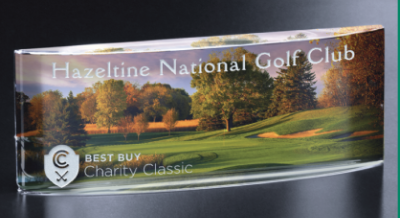To understand the recent push for color products that’s dominating the industry, Bridget Dahlgren, vice president of marketing, Crystal D, points to what happened with the film industry decades ago. “If you’re watching a movie in black and white, it’s so different than if you’re watching it in color. With color, so many more emotions are evoked.”
Color Rush
Demand for Color-Finished Products is Booming.
By: Matt Schur
(Originally published in the May/June 2022 issue of Insights.)
To understand the recent push for color products that’s dominating the industry, Bridget Dahlgren, vice president of marketing, Crystal D, points to what happened with the film industry decades ago. “If you’re watching a movie in black and white, it’s so different than if you’re watching it in color. With color, so many more emotions are evoked.”
The same is true for awards and personalization products, where there’s an urge to capture and evoke emotion, Dahlgren says. Plus, after a sea of black and white products for years, the color wave is having a moment because it’s different, says Crystal Evans, president, Conejo Awards. “It gives people something new and exciting to look at—they’re looking for that ‘wow’ factor.” That wow factor is how trends start to develop, Evans says, because people see a cool color product and want to imitate it.

This current push for color products isn’t going away any time soon, says Dana Keller, fabrication and support manager, JDS. The trend, he says, started taking off three years ago and will keep exploding out. “Everywhere you go, it’s color now,” Keller says. “I don’t see anything that’s basic anymore. Everyone wants personalization, and they want to personalize with their color, their picture, their graphic. I think it’s the future, and investments need to be made to prepare your business for color.”
Paving the Way
Technology is helping to fuel the wave. In years past, Keller says, technology wasn’t as capable and user-friendly as it is now. Recent advances have made the software easier to use while the machines break down less and self-clean. The enhanced capabilities are also helping people design more creative products, “because we’re able to produce more colors and more shades of colors,” Dahlgren says.

Younger employees are pushing boundaries, too. “A younger, tech-savvy generation is getting into the workforce, some of whom came out of school with design degrees, and they’re not afraid to dive into this industry and purchase a UV printer or sublimation system,” Keller says.
But creating color products isn’t limited to younger generations. Keller says the color trend is touching all segments, from legacy trophy makers to hobbyists. Just as wide ranging are the types of products color is going onto, everything from tumblers and glass to wood, plastic and metal. That being said, acrylic with color is selling at about 25 times the pace of any other products for Stephen Capper, CRM, president, A-1 Awards. “Acrylics with color, especially for simple and moderately priced items, are what our clients are really liking,” Capper says.

Colors can be limited, like just a pop of red for a logo, to full-scale pictures. For Crystal D, Dahlgren has seen a surge in photos of people and scenes for personal and corporate awards. “People are taking pictures of signature golf holes and putting them on awards. Or, if it’s a sales award, we’re seeing inclusion of photos of the actual people being honored that goes on the award.”
Companies have latched onto the potential marketing bonus of these products, too. “It’s a win-win for companies because they can provide that recognition, and then it also acts as a bit of self-marketing,” Evans says. “I had a marketing client from one company tell me it was a great idea to incorporate a color logo because they were giving awards to people outside the organization. The recipient is going to display that award in their office or home, and the logo will have multiple exposure points, with the color really capturing your attention.”
Taking Advantage
With new color products, retailers should step outside their comfort zones, Keller says. “You have to be able to adjust and keep up with the times if you want to diversify your business,” he says. “The industry is changing so much that you can’t always rely on the work you’ve been doing for the last 20 years. We’ve seen with COVID that a lot of companies have found a way to generate new forms of income and do well.”
Diving into the color arena might require reaching out to peers, studying new technology, thinking about staff capabilities and generally figuring out what will work for your business. To that end, Keller says, suppliers and manufacturers can be a partner in the learning process. For instance, JDS’ website offers templates and how-to videos. Plus, tech support can answer questions on sublimation, lasers or any number of one-off topics, “whether it’s questions about the best method to handle an order of 1,000 products or just what we’re seeing for trends and products that we’re selling,” Keller says.
In addition to learning from suppliers and manufacturers, Evans recommends looking into peer-oriented advice, such as tapping into YouTube videos, APA’s forums and speaking with other people in the awards and personalization industry. And, she says, be sure to practice, practice, practice. “It takes a lot of time to figure out what you’re doing, what you need, what pieces to prep to get the best result,” Evans says. “Don’t buy the machine, immediately take an order for 100 pieces and then be killing yourself for two weeks to try and get it to look right and complete the order.”
Once you have the tech know-how down, it’s important to capitalize on marketing your new capabilities, particularly in your showroom. “Putting color products in the showroom on display gives people a better visual of the product,” Evans says. “You can send mock-ups all day, but looking at it on a screen is not the same as seeing the physical piece.”
Capper also recommends looking to create unique products at a multitude of price points: “You want to create a product line that can be made in a range of price points so that you can identify with every budget that’s out there.”
Great Expectations
The constant challenge with color products is getting the exact right blend of colors that clients want. As Capper points out, if you don’t have the exact right settings for Coca-Cola, for example, “you’ll never sell them because it has to be exactly their color.”
“Technology has improved to the point where we can get really close to exact color matches,” Dahlgren says. But while there is the ability to make close matches, that doesn’t make it easy. A lot of elements can change how a piece looks, whether that’s viewing the product in sunlight versus underneath a fluorescent bulb; color mock-ups on one person’s phone compared to another person’s computer screen; a batch of ink being a little different; or the differences in colors in how they interact on different substrates.
“As technology gets better, these problems are getting more infrequent while being easier to correct,” Keller says. “You’re not seeing as many inconsistencies as with previous equipment.”

Even still, setting client expectations is critical, starting with the first consultation. Let clients know that 100% matches are unlikely, Evans says. “I especially pay close attention to blues and purples because CMYK, RGB, everything is slightly different,” Evans says.
Showroom display pieces are important for Evans, since people can see and feel what the finished product will be like. Don’t be afraid to offer samples, either. “If someone’s really confused about a color, you can offer a pre-production sample,” Evans says. “There’s nothing wrong with charging for that. The goal is for the client to be happy and refer others to you. So why risk it? If you have an order for 50 awards, you don’t want to finish all 50 only to redo the whole order because something was wrong with the color.”
Given all the work that goes into these color products—the increased time in consulting with the client, the need to pay for and maintain equipment, a more-desirable product—retailers should carefully assess their costs when pricing. “Because that end product is so much more impressive to the client, you have the ability to recoup costs appropriately,” Evans says. “Don’t be afraid to market your product and price your products appropriately. You’re not here to price gouge people, but there’s a lot more labor and equipment maintenance that goes into it.”
Ultimately, though, just because these products are new doesn’t mean the sales approach changes, Capper says. At the end of the day, businesses still need to sit down and listen to what their customers really want. “Whatever the color, whatever the design, be adaptable to what the person is looking for,” Capper says. “You have to have a conversation with them, ask questions and be willing to learn what they want.”
Join Today and Invest in Your Business
When you become a member of the Awards and Personalization Association, you will receive access to the print and online editions of Insights Magazine along with many other valuable benefits. Explore how we can help you get connected with industry experts, increase your skills and knowledge through relevant learning opportunities, and save money with discounts for your business.
Learn More